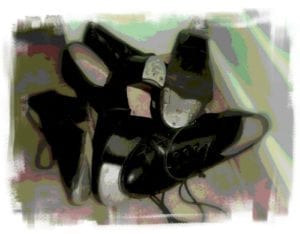Jill Purtee
Surprise, Arizona, United States

Tap Shoes. Artwork by Siaron James, 2003, on Flickr. CC BY 2.0.
Forty years ago I worked in a four-bed pediatric intensive care unit nestled in the pediatric ward. Every few weeks amongst the beeps and alarms, I heard the clicking of tap shoes coming down the pediatric ward hallway. My morning hug from Alma, a young girl with Diamond-Blackfan anemia, followed shortly thereafter. Her family did not have much money and those were Alma’s only shoes.
Alma’s rare condition, Diamond-Blackfan anemia, affects five to seven out of a million newborns in the world.1 Her rare condition required frequent blood transfusions since her bone marrow did not produce enough red blood cells.4
Alma became a permanent fixture on the pediatric ward. She came into my life in her pre-school or school-age years, so the typical infant-onset of symptoms of fatigue, weakness, and pallor1 were not present. Perhaps the passing of time has made her features fade in my memory. Perhaps because I grew to love this little girl, I overlooked some of the typical features of Diamond-Blackfan. The list is long, but I recall her exhibiting only a couple of them—a wide and flat nose bridge and small ears that sit low.1
But I do remember her smile.
The sound of tap shoes stopped as Alma entered the intensive care unit. With my morning hug, came an expected and unpleasant whiff from this girl with dark brown skin, uncombed hair, and a smile as big as Texas. Knowing her answer, I asked the question anyway, “Alma, did you brush your teeth this morning?”
“No.” Still smiling.
Her toothbrush was in her “yoom.” She could not pronounce her Rs.
This whiff occurred every morning, and as her mother never packed her toothbrush, we kept her toothbrush and toothpaste on the ward rather than running up her hospital bill. We stored the items in the narcotic cabinet so that everyone would remember where to find them.
On slow days in the unit, Alma spent time sitting with me at the nurses’ desk. She colored pictures as I worked. She sang ABC’s, which she stumbled over at the same place every single time—for years. I think it was the U.
In time, Alma outgrew her tap shoes and became more inquiring.
“Where is that blood from?” she asked someone.
When she found out that the blood was from a donor, she wanted no part of it. Not transfusing into her anyway. Alma’s body needed transfusions since her bone marrow did not produce enough red blood cells. The transfusions replenished her body with red blood cells, which carried oxygen to the cells in her body. Someone eventually came up with a clever way for Alma to accept her transfusions, but that solution escapes me now.
Unlike forty years ago, these days there are organizations and support resources for families of children with Diamond-Blackfan.4 Treatment ranges from no treatment for mild cases, to a temporary trial of corticosteroids, to blood transfusions.4 The only cure is a stem cell transplant.3 Delayed diagnosis leads to sickness or death.5 Diamond-Blackfan anemia is a potentially life-threatening condition.2
To my knowledge, Alma never asked why she had Diamond-Blackfan. The anemia is caused by a mutation in the genes that eventually lead to the production of ribosomes. With a shortage of ribosomes, blood-forming cells in the bone marrow self-destruct, resulting in anemia. The disorder can be identified with genetic testing.1 Fifty-five percent of cases of Diamond-Blackfan originate from a new mutation. The other forty-five percent are inherited in an autosomal dominant pattern. Only one parent need be affected.1 Rarely is it transmitted in an X-linked manner.4 A woman who is a carrier but without disease has a fifty percent chance of passing the disease on to her offspring.3
Because of frequent blood transfusions, Alma developed the most common complication of transfusion recipients, transfusion-related iron overload.3 Her condition was treated with chelation therapy.
Decades have past since my interaction with Alma. But many years ago, I learned that Alma had died. I did not get the specifics and I do not know if she ever developed one of the complications of Diamond-Blackfan, which may include myelodysplastic syndrome, acute myeloid leukemia, osteosarcoma, or other cancers.1
All I know is that this precious little girl, who endured many a needle stick and who enriched my life, was gone.
And I think of her every time I see a pair of tap shoes.
Bibliography
- “Diamond-Blackfan Anemia.” Genetics Home Reference. NIH. U.S. National Library of medicine. https://ghr.nlm.nih.gov/condition. January 7, 2020. Accessed: 1-4-20
- Boston Children’s Hospital [internet]. “Blackfan Diamond Anemia.” http://www.chilrenshospital.org/conditions-and-treatments/conditions/d/diamond-blackfan-anemia. Boston Children’s Hospital. Accessed 1-7-20.
- Clinton, C & Cazda HT. “Diamond-Blackfan Anemia.” GeneReviews NCBI Bookshelf [internet]. March 7, 2019. Accessed: 1-4-20.
- Diamond-Blackfan Anemia. Genetic and Rare Diseases. NIH. National Center for Advancing Translational Sciences [internet]. August 19, 2019. Accessed: 1-4-20.
- Gadhiya, K & Budh, DP. “Diamond Blackfan Anemia.” https://www.ncbi.nlm.nih.gov/books/NBK545302/. StatPearls [internet]. November 23, 2019. Accessed: 1-4-20.
- Noel, CB et al. “Diamond-Blackfan Anemia RPL35A: a case report.” Journal of Medical Case Reports. J Med Case Rep 2019 June 18; 13 (1): 185. doi: 10.1186/s1325-109-2127-3. 1-1-70. Accessed 1-4-20.
JILL PURTEE, MSN, APRN, CPNP, RN, grew up with two brothers in a small Oklahoma town, where she was a percussionist through high school. After moves to Nebraska/Kansas/Texas, she wore many hats (or caps) in her career: registered nurse (pediatrics/pediatric intensive care), college nursing instructor, hospital nurse educator, and pediatric nurse practitioner. After selling their New Mexico bed and breakfast, Jill and her husband settled in Arizona, where she still practices and writes picture books and board books. She enjoys children, dogs, yoga/pilates, walking, golf, reading and spending time with family and friends. She loves to laugh.
Submitted for the 2019–2020 Blood Writing Contest

Leave a Reply